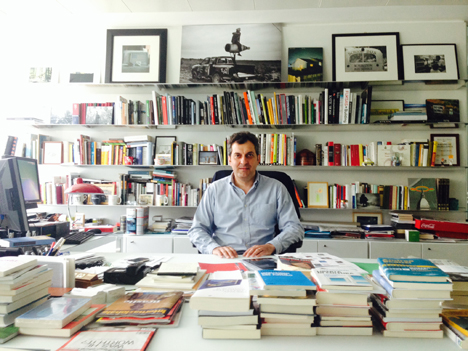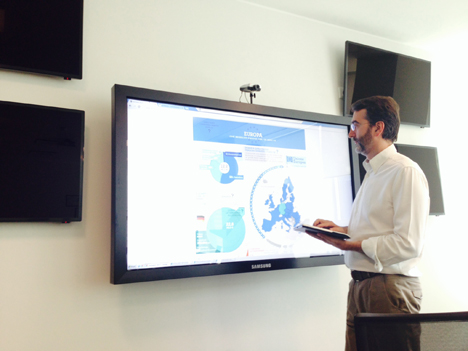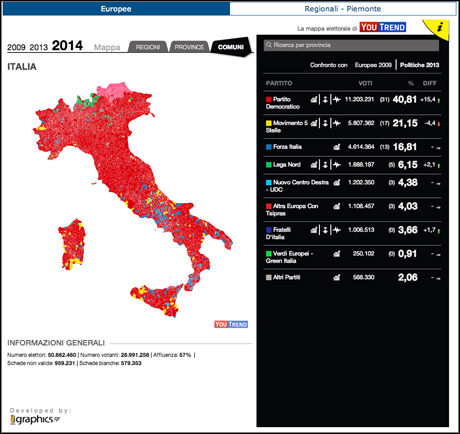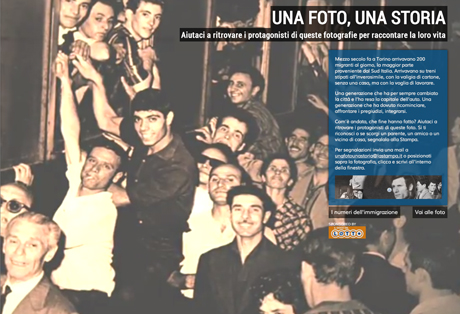
Before joining La Stampa as editor-in-chief, Mario Calabresi spent three years as the New York Correspondent for Italian daily La Reppublica.
Half of that time was spent on the campaign trail of Barack Obama, travelling the country to document the build up to his election, while also taking the chance to learn from the experience of local US news organisations.
"I visited something like 36 American states in 18 months," Calabresi told Journalism.co.uk in his Torino office, books on law, history and political thought piled high on his multiple desks and the shelves behind him.
"Everywhere I tried to visit the headquarters of the local newspaper, from the Dallas Morning News, The Star Ledger in New Jersey or Miami Herald or a very small newspaper in Colorado. Everywhere.We have to change our behaviour and way of thinking because our behaviour is in part the same behaviour of a news organisation of the last centuryMario Calabresi, La Stampa
"And I understood how important it is to break the wall between the traditional work flow of the paper edition and the website."
This 'breaking of the wall' involved restructuring on a number of levels internally – from La Stampa's content management system to a new office building, complete with a newsroom of concentric circles and video studio, start-up space and museum – but Calabresi said that, despite the changes, the mental hurdle is the hardest to overcome.
"Now we have to change our behaviour and way of thinking because our behaviour is in part the same behaviour of a news organisation of the last century," he said.
"You are a journalist of a news organisation called La Stampa. You are not a journalist of the paper."

Mario Calabresi, editor-in-chief of La Stampa, in his Turin office
Since his tenure began, La Stampa has continued to experiment in how to better make use of the digital tools and opportunities the internet offers, many of which have revolved around the Media Lab, founded by the outlet in late 2013.
"The idea was we wanted to learn and understand how to use new storytelling opportunities and we wanted to have kind of a laboratory," Marco Bardazzi, La Stampa's digital editor, told Journalism.co.uk.
"We wanted to get our hands dirty with new storytelling techniques."
Bardazzi described a number of projects and innovations that have been successful, and where the organisation will be looking in the future.
The academy
The Media Lab was initially intended as a space to host the various digital projects La Stampa journalists were turning out, but it soon came to involve young designers and developers from outside the organisation.
In early 2014, La Stampa partnered with Google to create an in-house 'academy' for digital innovation in news, inviting successful applicants to work in teams around stories and projects for the website.
Although the academy officially finished in February, attendees are often invited back to work on further ideas.It's much better to think about becoming, even, an incubator of start-upsMarco Bardazzi, La Stampa
"These are young people in the academy, they come here from time to time," Bardazzi said. "They are not La Stampa journalists fully but I don't think we can work only with our own staff."
The point was to open the up the newsroom to "contaminate" it with other professions and disciplines, said Bardazzi, to find new and interesting ways of approaching stories.
A number of those involved in the academy have now work occasionally for La Stampa on a freelance basis, or have started their own productions companies. One such example is the start-up Limpido, responsible for an interactive looking at how different countries finance the European Union.
"It's much better to think about becoming, even, an incubator of start-ups," Bardazzi said. "So we are helping a bunch of young journalists here to develop their own start-ups [and] freelance sometimes."
This openness extends to another new feature of Calabresi's – inviting well-known individuals from various online communities to be La Stampa's social media editor on a temporary and rotating basis.
"This decision and ability to open to other people outside of our traditional journalistic labour market [is important]," he said, and inviting young creatives to work at La Stampa in the academy, or the new practice of a rotating social media editor embodies that culture of open journalism.
"[The social media editor] changes between important figures in the social media debate," Bardazzi continued. "That's important to have a discussion and to confront [ideas] and have a different exchange of ideas everyday."

Marco Bardazzi, digital editor of La Stampa, exploring the Limpido interactive
Elections
The European Elections were a major feature in terms of digital innovation at La Stampa, providing a prize opportunity to experiment with maps and data.
La Stampa worked with YouTrend, an Italian polling and research organisation, to create interactive maps to let readers explore election results for both the recent national and European elections.
The maps updated live throughout the elections – a process Bardazzi said entailed "weeks" of preparation with developers – and also allowed readers to investigate the polling data at various administrative levels: from national, through regional and provincial, right down to the individual communities and constituencies.
"The newness is not the availability of the data," said Bardazzi, "it is the way we are using the data in a journalistic way. There is journalism involved in this because you are getting your own way of telling the story."

Screengrab from LaStampa.it of the interactive elections maps
Because Italian elections take place every year, Bardazzi believes there is ample scope to experiment with how best to tell the story of elections in different ways. For one, he said La Stampa would be seriously looking elements of semantic analysis on social media to get a different take on local and national elections.
"If we were following Twitter [Italian comedian turned politician] Beppe Grillo would have won by a landslide," he said. "Instead it was a different story. What we want to understand now and what we want to do is learn how to use big data, particularly from social, in a way that we can transform in maps. And not just about politics."
Sport, in particular, or entertainment and television shows all generate a lot of discussion online and looking at geo-located tweets can generate new stories on regional differences and opinions which can be visualised or analysed and published.
Archive material
Upon moving to the new offices in 2012, La Stampa opened a museum of the paper and digitised the paper's archives. This gives journalists multiple opportunities to revisit issues or historical events, a regular feature of the Media Lab, but also raises the possibility of larger features or interactives based around archive content.
One such project was 'A Photo, A Story'.
"It was 50 years since the last wave of migrants from Southern Italy to Turin," Bardazzi explained, "so we wanted to celebrate that anniversary and said let's publish pictures in the paper and ask people 'do you recognise yourself from when you were arriving? Where are you now?'"
Online, the reader's mouse cursor became a magnifying glass when one of the hundreds of photographs was selected, allowing readers to inspect the images closer to find themselves or their families.
With a sponsor paying the project costs, the journalists could follow up on the potential stories in more detail. The response was huge, said Bardazzi.

Screengrab from LaStampa.it of their 'One Photo, One Story' interactive
"Every time [readers] recognised themselves we were sending them a reporter with a camera and everything to tell the story," he said. "Now we have an archive of video interviews of people."
One of the bigger stories involved a man whose family had a simple country life on a farm before moving to Turin, but he now owned seven restaurants across the city.
Webcar
Bardazzi and Calabresi were particularly proud of the organisation's webcar, a converted Fiat 500L providing satellite link-up and editing facilities on the move that Calabresi said proved it was "possible to have low cost live coverage for the website".
"We weren't able to do live coverage or streaming before," Bardazzi said, "we had to hire outside services every time we wanted to do something live. With this we go everywhere in Italy and in 15 minutes we are live and the satellite quality is very good."
Editorially it gives the team greater flexibility to provide live coverage and develop their video skills, something Bardazzi said the organisation is keen to advance, while it also makes perfect sense from a financial perspective.
"It's much less expensive," he said of the webcar, developed in partnership with Fiat and Eutelsat. "If you think that one hour of live streaming with the web car costs us something like €20 (£16/$27) for the satellite and a TV network usually for the same hour, would need €1,000 (£800/$1340) and they would charge you for that."
Future
While happy with the progress being made, Calabresi believes there is still work to do in how the organisation and its journalists approach their roles in the age of digital media.
"We have a lot of material but we need to reorganise and rethink everything," he said, "and I think we have to create different products for different specific groups of people.At the end of the day you have to go to the market with the best and the biggest catch of the day. You have to put the catch of the day in the newspaper.Mario Calabresi, La Stampa
"If you are interested in sports or Juventus we have to pack and give you this everyday. Some people say this isn't the time for general news and general products. I don't think so. I think we have to cover news and general products but with the ability to choose and pack different verticals."
Applying this thinking online has already begun, but Calabresi said the same could be said of the organisation's approach to print.
In recent months La Stampa has been partnering with leading European news organisations around specific issues and collecting their combined reportage in monthly special editions of the newspaper.
The most recent looked at environmental issues, including interviews with Bill Gates and Michelle Obama, a feature on the largest seed bank in the world at Svalbard in Norway, a special wrap cover and other coverage alongside the daily news.
Such special editions regularly see a "five to ten per cent increase" in print sales, said Calabresi, and companies are often willing to pay up to double the standard price of advertising to appear alongside more relevant content.
"The breaking news, the website, it is like a river," he said. "You have to register all the water that's passed through during the day and you also have to fish.
"At the end of the day you have to go to the market with the best and the biggest catch of the day. You have to put the catch of the day in the newspaper. That's it. We have to change this."
Free daily newsletter
If you like our news and feature articles, you can sign up to receive our free daily (Mon-Fri) email newsletter (mobile friendly).
Related articles
- What AI can do for your newsroom: tips from Ring Publishing's latest handbook
- 200 speakers you need at your next journalism event to avoid all-male panels
- How young leaders can shape the future of the media industry
- Tools, tactics, and success stories of newsroom innovation in 2023
- How news brands can win over young audiences, with Danuta Breguła









